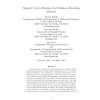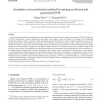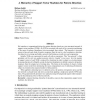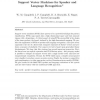141
Voted
ICCV
2011
IEEE
14 years 18 days ago
2011
IEEE
Adaptive tracking-by-detection methods are widely used in computer vision for tracking arbitrary objects. Current approaches treat the tracking problem as a classification task a...
132
click to vote
SCHOLARPEDIA
2008
14 years 11 months ago
2008
We present a novel method for clustering using the support vector machine approach. Data points are mapped to a high dimensional feature space, where support vectors are used to d...
105
Voted
OL
2007
15 years 2 days ago
2007
In this paper we construct the linear support vector machine (SVM) based on the nonlinear rescaling (NR) methodology (see [9, 11, 10] and references therein). The formulation of t...
109
click to vote
NECO
1998
15 years 7 days ago
1998
Support Vector Machines (SVMs) perform pattern recognition between two point classes by nding a decision surface determined by certain points of the training set, termed Support V...
123
click to vote
PR
2006
15 years 15 days ago
2006
A novel training method has been proposed for increasing efficiency and generalization of support vector machine (SVM). The efficiency of SVM in classification is directly determi...
118
click to vote
FSS
2007
15 years 16 days ago
2007
The relationship between support vector machines (SVMs) and Takagi–Sugeno–Kang (TSK) fuzzy systems is shown. An exact representation of SVMs as TSK fuzzy systems is given for ...
116
click to vote
JMLR
2006
15 years 16 days ago
2006
Support vector machines (SVMs), though accurate, are not preferred in applications requiring great classification speed, due to the number of support vectors being large. To overc...
116
Voted
JMLR
2006
15 years 16 days ago
2006
We introduce a computational design for pattern detection based on a tree-structured network of support vector machines (SVMs). An SVM is associated with each cell in a recursive ...
125
click to vote
CSL
2006
Springer
15 years 18 days ago
2006
Springer
Support vector machines (SVMs) have proven to be a powerful technique for pattern classification. SVMs map inputs into a high dimensional space and then separate classes with a hy...
CORR
2008
Springer
15 years 20 days ago
2008
Springer
In this paper, we propose a method for support vector machine classification using indefinite kernels. Instead of directly minimizing or stabilizing a nonconvex loss function, our...




